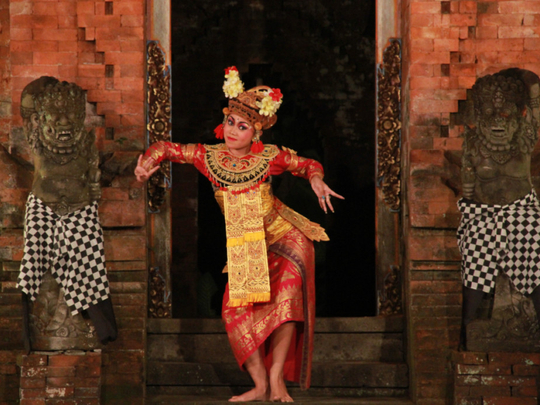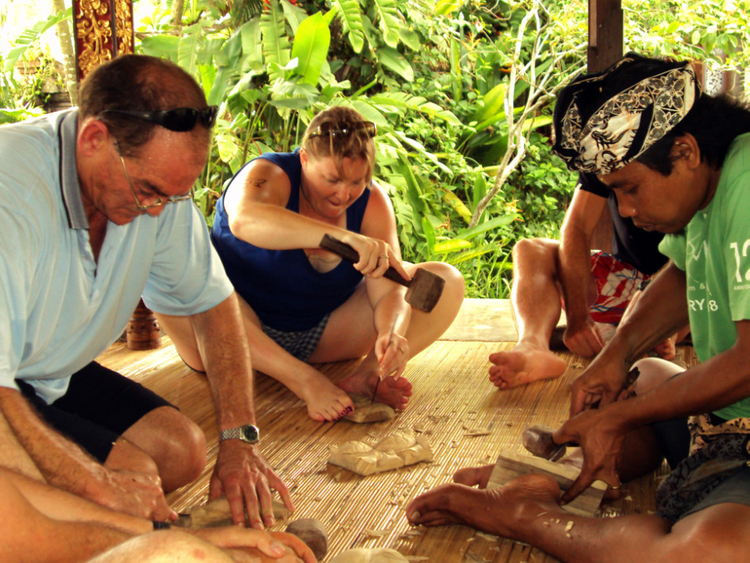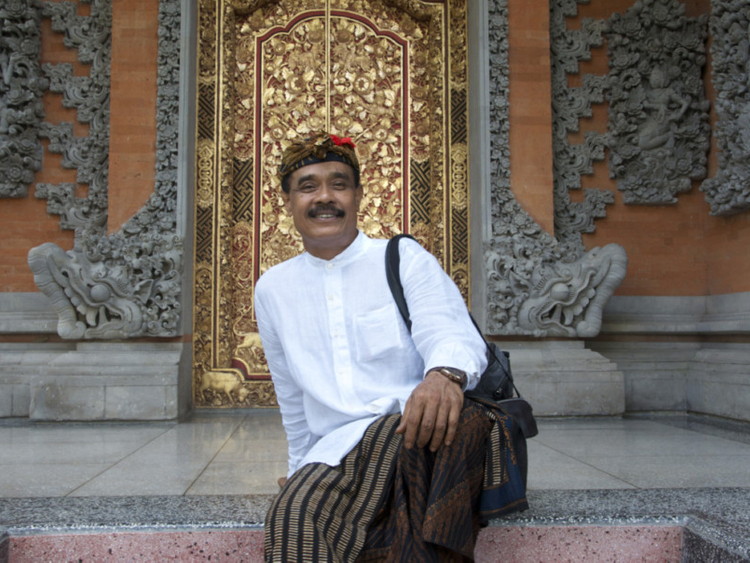
In the quaint central Balinese town of Ubud, the boulevards are lined with penjor, the festive ornamental bamboo poles that are a reminder of Galungan and Kuningan, the beginning and conclusion of the 10-day Balinese festival to celebrate the triumph of good over evil. Ubud represents the pinnacle of Bali’s indulgent attitude towards art and creativity. This cultural town showcases how Bali’s contemporary artists studied and evolved their expressions with the help of friendly expatriate European artists. Ubud’s unique art story is revealed step-by-step through various expressions that range from woodcarvings to paintings housed in this small town’s huge art galleries. They they mark two eras of art — before and after the Second World War.
Of the many art galleries in Ubud, the most remarkable is Agung Rai Museum of Art (Arma). The museum’s campus is a spectacular sanctuary offering not just brilliant art but a large green square connected with tree-canopied walkways that skirt orchid gardens and lotus ponds.
“In Bali, everything is art,” says Agung Rai, the founder of Arma.
Ubud is steeped in a variety of traditional Balinese performing arts. Balinese music and dance, in particular, have been celebrated for their contributions to world heritage. Originally, these art forms were an outgrowth of the native Hindu religion, but today they represent a bygone era of a rich culture that celebrated the grace of the human form. The town’s galleries showcase inspirations drawn from religious epics and Balinese daily life alike.
The vibrant culture and natural beauty of Bali has touched many artists upon their random visit to the island and compelled them to stay back for good. Some of them have reshaped the artistic course of the land. The Arma collection includes original works of some of these international artists — Dutch artists Rudolph Bonnet, Willem Hofker, Hans Snel, Willem Dooijewaard and Arie Smit; Le Majeur de Merpres from Belgium, and Donald Friend from Australia. Rai attributes the awakening of international artists’ interest in the local arts scene since Walter Spies came to Ubud. “Walter Spies was a visionary who built bridges between the Western and Balinese cultures and has therefore a special place in our collection,” says Rai.
Spies (September 15, 1895-January 19, 1942) was a Russian-born German Primitivist painter. Primitivism is a Western art movement that borrows visual forms from non-Western or prehistoric peoples (such as Paul Gauguin’s inclusion of Tahitian motifs in his art works). The influence or borrowings of primitive art has been important to the development of modern art.
In 1923, Spies moved to Java, Indonesia. He lived in Djokjakarta and then in Ubud, Bali, starting from 1927. He is often credited with attracting the attention of Western cultural figures to the Balinese culture and arts in the 1930s. He also influenced the direction of Balinese art and Balinese drama.
“Spies, Bali’s most famous resident, was the son of a German diplomat in Moscow at the start of the World War. Spies was already well known in Europe as a painter in 1923. As fine a musician as he was a painter, after the war, he ran away from disorganised Europe to the East until he reached Java, where he was called by the Sultan of Djokjakarta to organise and lead a Western orchestra. He lived for years in the Sultan’s court learning their music. Then one day he went to Bali on a visit and remained there ever since,” wrote Mexican artist and anthropologist Miguel Covarrubias, who lived and researched in Bali those days.
The Arma Foundation in Bali was established in 1996 to promote and preserve Balinese art and culture. The campus includes a world-class museum that includes works not only by leading Balinese artists such as Ida Bagus Made Poleng, A.A. Gede Sobrat, I Gusti Nyoman Lempad, I Gusti Ketut Kodo, A.A. Gde Meregeg and Nyoman Meja, but also artists from all over the Indonesian archipelago. You will find renowned names as Affandi, Sudjono, Srihadi Soedarsono, Raden Saleh and many others, but also work of upcoming masters. The founder has put his faith in selected modern artists such as Putu Wirantawan.
The Arma campus also offers free Sanggar (“dance and music classes”) at its centre for visual and performing arts. Founded in 1998, Sanggar is an informal arts school. Hundreds of children, teenagers and adults benefit regularly from Sanggar. Many who got trained here have gone on to perform in their communities as skilled dancers and musicians. Community art events are a big feature of Bali’s local scene.
Current affairs and challenges
Recent events threaten the continuity of these traditional art forms. The shift within the Balinese society from agrarian to industrial was quite swift, making visible the lack of support for arts. Globalisation has brought a change in the process of creation of art from a balanced spiritual offering towards the basis for a wage system. Two terrorist bombings were a huge blow to local tourism, which accounts for 90 per cent of the island’s income. During good seasons, the median income is roughly $5 (Dh18) a day. But now the local population struggles to fulfil their basic needs. Other factors include a lack of documentation about traditional dance and music, and the significant loss of master teachers through age and passing.
The continuation of the Sanggar programme is seriously threatened by income loss in other areas of operation due to the drop in tourism and student participation. “There is a misunderstanding in how people see this situation. It is not only because of the drop of tourism that Sanggar is losing children. It is mostly because nowadays children have so many classes and extra-curricular activities at school. They don’t have much time left to do other things. Also, we have no financial support from any government. We are supporting the foundation solely with the help of our family businesses — the resort, restaurants and other services. We try and organise regular fundraisers. At times we collaborate with international artists to support our foundation,” says Rai.
Learn at Arma
Arma is more than an art museum. It is a centre for visual and performing arts, and provides a permanent collection of paintings, special temporary exhibitions, theatre performances, dance, music and painting classes. It has an exhaustive bookshop, library and reading room apart from separate areas dedicated for cultural workshops, conferences, seminar and training programmes.
Its vision is to become internationally renowned for Balinese and Indonesian culture. The museum offers several programmes to people from various cultural backgrounds, especially for those who wish to experience and learn more about Bali’s unique cultural heritage. “At Arma, one can learn and experience Bali’s art and culture daily. It offers a one-stop cultural learning experience through its various cultural workshops such as gamelan (traditional Balinese percussion) lessons, dance classes and batik painting techniques,” says Bagus Mustika, general manager, Arma.
Special programme
With the aim of preserving the traditional Legong, the Legong Keraton of Peliatan was specially designed to showcase this ancient dance-drama regularly at the campus. Legong, popularly known as the dance of the virgins, is a sacred dance of the Hindu community in Bali, traditionally performed by young girls who have not yet reached puberty. Peliatan village is only about a mile and a half from the centre of Ubud and is known for its dancers.
Arma’s team of choreographers, music composers (musicologists), musicians and dancers is supported by international artists currently living in Ubud along with a permanently employed staff of photographers, audio-visual technicians, as well as an anthropologist and a historian of Balinese literature.
Arma is a testimony to one man’s dream. It tells the story of how one man on a tiny island is enough to preserve an era of brilliant art.
“You may learn that he [Agung Rai] started as a peddler and became a merchant, but before long you will understand that he never meant to ‘accumulate’, but instead to ‘show’. And what else could he show, if not the artistic representation of Balinese harmony? Hence his museum and resorts, where nature and man come together in total harmony — the same harmony that is seen shrinking elsewhere,” says Jean Couteau, a French philosopher and writer who currently lives in Ubud.
Rai’s inspiration
“Art is part of my being. It has always been so. As a child I was drawn to the workshops of the fabulous painters who were able to bring my culture to life with a piece of canvas, a few brushes and some paint. Art got under my skin and it stayed. My fascination and passion for the arts, in particular painting, developed into what I chose to be in life: a collector, protector and developer of the arts,” says Rai.
He attributes his inspiration to collections at The Puri Lukisan Museum and The Neka Museum. “I consider it a great blessing to have been able to buy, sell and collect art works. This passion formalised in 1980. I trained myself in seeking paintings that moved me, paintings I really connected to and that reflected the depth and sensitivity of the artist’s soul. I always felt a spiritual connection to the art I bought. The result of my collecting passion is now on display in the Museum [Arma].
“To guarantee and sustain its continuity, the museum is managed by The Arma Foundation. The funds raised by the foundation are used to contribute to the efforts in preserving, promoting and developing the arts and culture, not only of Bali, but of all Indonesia. For me, what has been accomplished until now is just the tip of the iceberg. My dream of continuously being able to contribute in preserving and promoting the art of Bali, specially in my hometown Ubud, is still alive. I dream of Ubud as an art centre forever, for everyone,” says Rai.
Art museums in Ubud
For generations, Ubud’s nobles have taken pride in their role as patrons of fine arts. Their sponsorship has helped make Ubud an artist’s haven, attracting creative people from all over Indonesia and abroad. The Ubud nobles’ careful cultivation of upcoming Balinese artists has borne fruit as present-day artists’ communities that continue to fill Ubud’s art galleries with their magic.
Whether you’re just looking or in the market to buy Balinese art for your personal collection, these Ubud art galleries should be at the top of any art traveller’s top agenda. Besides Arma, there are three prominent art museums in Ubud and many other small galleries run by artists living there.
The Puri Lukisan Museum is the oldest art museum in Bali, established in 1936 by The Pitamaha Artist Cooperative which was founded by Tjokorda Gde Agung Sukawati (the King of Ubud) and Tjokorda Gde Raka Sukawati (the King’s brother) along with two Western artists working in Bali at the time: Spies and Rudolf Bonnet. Its mission was to preserve and develop traditional Balinese art.
The museum has four separate buildings housing specific genres. The Pitamaha Gallery houses the pre-war (Second World War) modern traditional Balinese paintings (1930–1945) and artist I Gusti Nyoman Lempad’s works. The Ida Bagus Made Gallery houses artist Ida Bagus Nyana’s works. He was a talented wood sculptor and a gifted dancer. He is known for his impressionistic, elongated woodcarvings whose fluid shapes, devoid of excessive detail, often appear as if they had been pulled from taffy. His sculpture of the deity Pertiwi (Mother Earth), with its spidery legs and coiled serpent, is dreamlike and surreal. The Wayang Gallery houses Wayang (Javanese puppets) Painting Collection. The Founders Gallery houses the museum history and is used for temporary exhibitions or to showcase its new acquisitions.
The Blanco Renaissance Museum named after Spanish artist Antonio Blanco, is another popular museum located in Ubud. It opened in 1998. Blanco believed he has spiritual affinity to Miró and Salvador Dalí. Blanco landed in Bali in 1952. The King of Ubud gave Blanco a place to set up his home and studio in campuhan of Ubud where the rivers West Wos and East Wos meet — a sacred land. It is believed that Rsi Markandya, a Hindu sage from Java, discovered the healing properties of these rivers. Blanco and his Balinese wife, the celebrated dancer Ni Ronji, lived in this paradise-like mountain retreat, barely ever leaving it for the world outside. His studio and museum is now open to the public.
The Neka Art Museum opened 1982 and is named after Balinese teacher Suteja Neka who collected paintings as a means of artistic documentation. The museum has an amazing selection of works from many famous Balinese artists and expats who have lived here and influenced local artists.
Art therapy
The name of Ubud is derived from the word “ubad”, which means medicine in Balinese. The arts and therapy centre at Arma is named HEART. It aims to create the transformational “safe space” necessary for the participant to acquire deep insights of one’s own innate capacity for self-healing provides the participant those processes and tools necessary for inner transformation.
Ubud bridges a unique space between an unseen world of creative spirit and a contemporary world — complete in an ambience of artistic expression.
Archana R.D. aka B’lu is an artist-journalist based in the UAE who writes on global art and culture.















